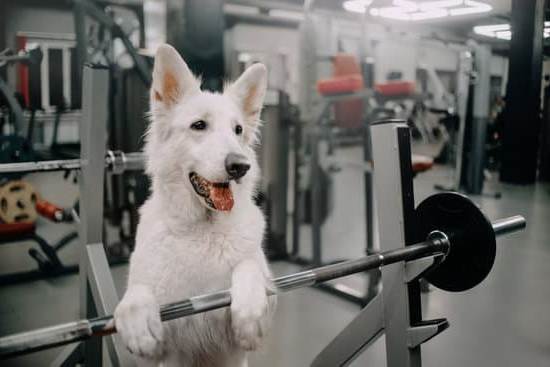Can you train your dog to close doors? Many dog owners may wonder about the possibility of teaching their furry companions this unique task.
Training your dog to perform such behaviors can not only be entertaining but also have practical benefits for both you and your pet. In this article, we will delve into the world of training dogs to close doors, exploring the benefits, principles, methods, and step-by-step guide to help you successfully teach your dog this skill.
Teaching your dog how to close doors can provide several advantages in your daily life. Not only can it be a useful trick that showcases your dog’s intelligence and obedience, but it can also offer convenience by eliminating the need for you to constantly get up and close doors around the house. Additionally, training your dog to perform such tasks can strengthen the bond between you and your pet through positive reinforcement and consistent training.
Understanding the basic training principles is essential when attempting to teach your dog new behaviors like closing doors. Positive reinforcement, consistency, patience, and clear communication are key components in effectively training dogs.
By following a structured approach based on these principles, you can increase the likelihood of success in teaching your dog to master door-closing. In the following sections of this article, we will discuss different methods and techniques that can help you achieve this goal with your furry companion.
The Benefits of Teaching Your Dog to Close Doors
Improved Independence and Convenience
Training your dog to close doors can significantly improve their independence and your convenience as a pet owner. Imagine being able to have your furry friend lend a helping paw by closing doors behind them, especially when you have your hands full or are in another room. This simple task can make a big difference in your daily routine and overall efficiency around the house.
Promotes Mental Stimulation
Teaching your dog new behaviors, such as closing doors, provides mental stimulation that helps keep them engaged and challenged. Dogs thrive on learning and problem-solving activities, so training them to perform tasks like closing doors can help prevent boredom and behavioral issues. It also strengthens the bond between you and your canine companion through positive interactions and teamwork.
Enhanced Safety and Security
Having a dog that knows how to close doors can contribute to enhanced safety and security within your home. By being able to close a door behind them, dogs can prevent accidental escapes or keep certain areas off-limits when needed. This skill may also come in handy during emergencies, where quickly securing doors can be crucial for maintaining the safety of everyone in the household.
Understanding the Basic Training Principles for Teaching Dogs New Behaviors
Dogs are incredibly intelligent creatures capable of learning a wide range of behaviors, including the ability to close doors. Teaching your dog this unique skill can not only impress your friends and family but also offer practical benefits in daily life. By understanding the basic training principles for teaching dogs new behaviors, you can effectively communicate with your furry companion and help them develop this useful skill.
One fundamental principle when training your dog is to use positive reinforcement. This involves rewarding your dog with treats, praise, or playtime whenever they exhibit the desired behavior, such as nudging a door closed. This positive association encourages your dog to repeat the behavior in hopes of receiving another reward. Consistency is key in training, so be sure to reward your dog every time they successfully close a door until the behavior becomes second nature to them.
It’s essential to keep training sessions short and frequent to prevent overwhelming your dog. Dogs have shorter attention spans, so breaking up the training into multiple sessions throughout the day can improve their retention and overall success in learning new behaviors, like closing doors.
Patience is also crucial when teaching your dog new skills – remember that every pup learns at its own pace, so remain calm and supportive throughout the training process. With dedication and positive reinforcement, you can train your dog to close doors effectively.
| Training Principle | Description |
|---|---|
| Positive Reinforcement | Rewarding dogs with treats or praise for exhibiting desired behaviors |
| Consistency | Reinforcing behavior every time it occurs to establish a routine |
| Patience | Taking time to allow dogs to learn at their own pace without rushing them |
Choosing the Right Method for Training Your Dog to Close Doors
Understanding Your Dog’s Learning Style
Before diving into training your dog to close doors, it’s important to consider the individual learning style of your furry friend. Some dogs respond well to visual cues, while others may prefer verbal commands or physical demonstrations. By understanding how your dog learns best, you can tailor your training approach to suit their needs and achieve the desired results more effectively.
Positive Reinforcement vs. Correction-Based Training
When it comes to teaching your dog new behaviors, including closing doors, positive reinforcement is often the most effective method. Rewarding your dog with treats, praise, or playtime when they exhibit the desired behavior encourages them to repeat it in the future.
On the other hand, correction-based training methods that involve punishment or harsh corrections can you train your dog to close doors can lead to fear and anxiety in your furry companion, making them less likely to learn and retain new skills.
Consistency and Patience Are Key
Regardless of the method you choose for training your dog to close doors, consistency and patience are essential factors for success. Establish a clear routine and practice regularly with your dog to reinforce the desired behavior. Be patient with your furry friend as they learn a new skill – remember that every dog progresses at their own pace. With time, dedication, and positive reinforcement, you can help your dog master the art of closing doors with confidence and ease.
Step-by-Step Guide to Teaching Your Dog to Close Doors Using Positive Reinforcement
Teaching your dog to close doors can be a fun and practical skill to add to their repertoire. Not only does it enhance their training and mental stimulation, but it also provides you with convenience and efficiency in your daily life. Positive reinforcement is a key method for teaching dogs new behaviors, including how to close doors.
One of the fundamental principles of positive reinforcement training is rewarding your dog for exhibiting the desired behavior. In the case of closing doors, you can start by associating the action with a command such as “close door,” followed by giving your dog a treat or praise every time they push the door closed. Consistency is crucial in this process, as dogs learn best through repetition and reinforcement.
To begin training your dog to close doors using positive reinforcement, follow these steps:
- Start by getting your dog familiar with the door you want them to close.
- Use treats or toys to lure them towards pushing the door with their nose or paw.
- Pair a verbal command like “close door” with the action of pushing the door closed.
- Reward your dog immediately after they successfully close the door.
- Practice this routine consistently, gradually reducing treats as your dog becomes more proficient at closing doors on command.
With patience and dedication, most dogs can learn how to close doors using positive reinforcement methods. Remember that each dog learns at its own pace, so be sure to tailor your training approach to suit your furry friend’s individual needs and preferences.
| Positive Reinforcement Training Tips for Teaching Dogs to Close Doors | Benefits |
|---|---|
| Use treats or toys as rewards | Enhanced mental stimulation |
| Be consistent in associating commands with actions | Convenience in daily life |
| Practice regularly and adjust based on progress | Improved bond between owner and pet |
Troubleshooting Common Challenges When Teaching Your Dog to Close Doors
When teaching your dog to close doors, it is common to encounter certain challenges along the way. However, with patience and consistency, these hurdles can be overcome. Here are some common issues that you may face while training your dog to close doors, along with potential solutions:
- Lack of motivation: Some dogs may not be initially motivated to learn how to close doors. In such cases, it is essential to find out what motivates your dog – whether it’s treats, toys, or praise – and use that as a reward during training sessions.
- Fear of the door: If your dog displays fear or anxiety towards the door, take a step back and desensitize them to the door slowly. Start by rewarding your dog for approaching the door without closing it, then gradually work towards rewarding them for nudging it closed.
- Difficulty in understanding cues: Dogs may struggle to understand what you are asking them to do when closing a door. Break down the behavior into smaller steps and reward each milestone achieved. Consistent practice and positive reinforcement will help reinforce the desired behavior.
It is important to remember that every dog is unique, and progress may vary from one canine companion to another. Stay patient and persistent in your training efforts, and always prioritize positive reinforcement techniques over punitive measures.
- Seek professional help if needed: If you are struggling with training your dog to close doors despite trying various methods, consider reaching out to a professional dog trainer for guidance.
- Take breaks during training sessions: Dogs can easily get overwhelmed or lose interest during lengthy training sessions. Break up the training into short, frequent sessions to keep your furry friend engaged and focused.
- Celebrate small victories: Recognize and celebrate even small progress made by your dog in learning how to close doors. Positive reinforcement will help build confidence in your pet and strengthen their bond with you.
By addressing these common challenges proactively and adapting your training approach accordingly, you can effectively teach your dog how to close doors with time and dedication. Remember, every successful behavior learned by your four-legged friend is a testament to both of your hard work and communication skills.
Advanced Training Techniques for Dogs Who Have Mastered the Basic Door-Closing Behavior
Once your dog has successfully mastered the basic door-closing behavior, you may want to explore advanced training techniques to enhance their skills further. These advanced techniques can help take your dog’s abilities to the next level and provide mental stimulation and enrichment for your furry friend.
Here are some advanced training techniques that you can implement to challenge your dog and continue their progress in closing doors:
- Introducing different types of doors: Once your dog is comfortable with closing a standard door, you can introduce different types of doors such as sliding doors, pocket doors, or even cabinet doors. This will help broaden their understanding of the concept and improve their overall problem-solving skills.
- Adding distractions: To make the training more challenging, you can introduce distractions while teaching your dog to close doors. This could include playing music, having other people or pets in the room, or using toys to grab their attention. By learning to focus and ignore distractions, your dog will become more reliable in performing the behavior.
- Increasing distance: Another way to advance your dog’s door-closing skills is by increasing the distance between them and the door. Start by gradually moving away from the door after giving them the command to close it. This will help strengthen their ability to understand cues from a distance and respond accordingly.
By incorporating these advanced training techniques into your dog’s routine, you can further enhance their capabilities and deepen the bond between you and your furry companion. Remember to be patient, consistent, and positive throughout the training process to ensure success in teaching your dog new skills such as closing doors.
Real-Life Success Stories of Dogs Who Have Been Trained to Close Doors
Many dog owners have successfully trained their furry companions to close doors, showcasing the intelligence and ability of our canine friends. Through consistent training and positive reinforcement, dogs can learn to perform this unique task with ease. Real-life success stories of dogs who have been trained to close doors serve as inspiration for other pet owners looking to teach their pups new behaviors.
One such success story is that of Max, a Labrador Retriever who quickly picked up on the door-closing command after just a few training sessions. His owner, Sarah, started by teaching Max basic obedience commands before moving on to more advanced tasks like closing doors. With patience and plenty of treats as rewards, Max soon became adept at closing doors around the house whenever asked.
Another inspiring tale is that of Luna, a mixed breed rescue dog who was initially shy and apprehensive about training. However, with the gentle guidance of her dedicated owner, Jake, Luna gradually learned how to close doors using positive reinforcement techniques.
Through consistent practice and praise, Luna gained confidence in her abilities and now confidently closes doors on command. These real-life success stories highlight how any dog, regardless of breed or background, can learn new skills with the right approach to training.
These heartwarming accounts demonstrate the bond between humans and their canine companions, showcasing the potential for dogs to learn and grow alongside their owners. By celebrating these achievements in training our four-legged friends, we can inspire more dog owners to explore the possibilities of teaching their dogs unique tasks like closing doors. With dedication, patience, and positive reinforcement, any dog can learn new behaviors and showcase their intelligence in surprising ways.
Conclusion
In conclusion, the question “Can you train your dog to close doors?” is met with a resounding yes. Teaching your furry companion to perform such a unique task not only showcases their intelligence and ability to learn but can also offer practical benefits in daily life. By investing time and effort into training your dog to close doors, you are not only enhancing their skills but also strengthening the bond between you and your canine friend.
Exploring the potential of training your dog to master new skills, like door-closing, can result in a more well-rounded and obedient pet. The basic training principles discussed in this article serve as a foundation for successfully teaching dogs new behaviors. By choosing the right method and employing positive reinforcement techniques, you can effectively communicate with your dog and guide them towards door-closing proficiency.
As highlighted by real-life success stories shared in this article, many dog owners have witnessed the remarkable capabilities of their pets when it comes to learning new tasks. With dedication, patience, and consistency, dogs have shown great progress in mastering the art of closing doors. Therefore, I encourage all dog owners to tap into the potential of training their furry companions to expand their skill set and enrich their relationship through shared accomplishments.
Frequently Asked Questions
Can I Teach My Dog to Close the Door?
Teaching your dog to close the door is definitely possible with patience and consistency. Begin by using treats or rewards to encourage your dog to nudge the door with their nose or paw. Repeat this process until they understand the action you want them to perform.
How Do You Teach a Dog to Close a Drawer?
Teaching a dog to close a drawer follows a similar process as teaching them to close a door. Start by associating a specific command with the action of pushing the drawer closed. Use positive reinforcement like treats or praise each time they successfully complete the task, gradually increasing difficulty as they learn.
What Is the Doorway Method for Dogs?
The doorway method for dogs involves using a physical barrier like a baby gate or an exercise pen at the entrance of a room where you’d like your dog to stay out or in. This method helps set boundaries and teaches dogs where they are allowed or not allowed, promoting good behavior and obedience.

Welcome to the blog! I am a professional dog trainer and have been working with dogs for many years. In this blog, I will be discussing various topics related to dog training, including tips, tricks, and advice. I hope you find this information helpful and informative. Thanks for reading!





